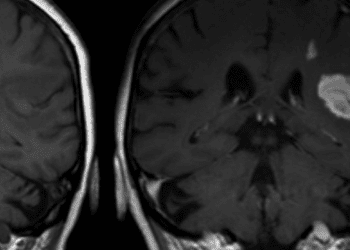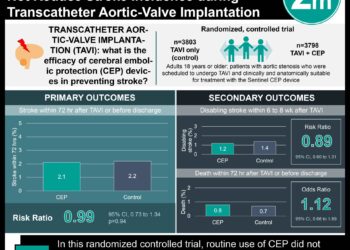2 Minute Medicine Rewind August 12, 2024
1. Biguanides and dipeptidyl peptidase-4 (DPP-4) inhibitors show no differences in major cardiac or cerebrovascular events, diabetic complications, or death in the Japanese population.
Evidence Rating Level: 2 (Good)
The initial pharmacologic intervention for type 2 diabetes mellitus (T2DM) includes biguanides and dipeptidyl peptidase-4 (DPP-4) inhibitors. Interestingly, guidelines differ worldwide as to which of the two is the first-line therapy. This retrospective cohort study aimed to fill the gap of comparative studies between biguanides and DPP-4 inhibitors by looking at their effects on the incidence of cardiac and cerebrovascular events, diabetic complications, and cost. By looking at patient treatment plans and codes for subsequent treatments, patients were assessed for the earliest cerebrovascular event, cardiac event, or mortality as the primary outcome. Secondary outcomes included the onset of any diabetes-related event including diabetic nephropathy, renal failure, diabetic retinopathy, and diabetic peripheral neuropathy. The average daily cost of medications was also recorded. Of the participants included, 514 were treated with a biguanide whereas 2570 were treated with a DPP-4 inhibitor with none on insulin. The incidence of cardio-cerebrovascular composite outcome (including cardiac events, cerebrovascular events, and death) did not vary significantly between either treatment (p = 0.544). Similarly, no significant difference in diabetic complication rate was seen between either treatment (p = 0.290). The cost, however, was significantly lower for participants using a biguanide (p < 0.001) at 60.5 ± 70.9 yen for biguanides and 123.6 ± 64.3 yen for DPP-4 inhibitors. A mean difference of 63.1 yen is 0.41 USD a day. The main limitation of this study for application outside of Japan where the study was conducted is the generalizability to another population as Japan is a highly homogenous society ethnically. However, similar studies should be conducted in other countries as this comparison is necessary to the treatment of patients worldwide.
1. In patients with an established history of atherosclerotic cardiovascular disease (ASCVD) randomized to either take a daily high (325mg) or low (81mg) dose aspirin, there was no interaction between race and the primary endpoint consisting of death, hospitalization for myocardial infarction, or stroke.
Evidence Rating Level: 1 (Excellent)
In the USA, there are disparities in the outcome of atherosclerotic cardiovascular disease (ASCVD) between Black and non-Black patients. This disparity is due to many factors, one of which may be the different reactions of platelets in self-reported Black patients to aspirin. Aspirin prevents clinical events in patients with ASCVD and is a recommended option for secondary prevention of cardiovascular events. However, no study has looked at the dose-dependent effect of aspirin on Black patients. The ADAPTABLE randomized controlled trial compared the effects of two different doses of aspirin (81mg or 325mg daily) on clinical outcomes of 15 076 patients in the USA. This study used ADAPTABLE to evaluate the dose-dependent effect of aspirin. The primary endpoint was a composite of death from any cause, hospitalization for myocardial infarction, or stroke. Secondary endpoints included coronary revascularization or coronary artery bypass graft. The primary safety endpoint was a hospitalization for bleeding requiring transfusion. Over the 26.2 months median follow-up, the primary effectiveness endpoint was significantly higher in Black and other participants relative to White participants (overall p value < 0.001). The dosage of aspirin did not affect primary effectiveness endpoint (p = 0.12), primary safety endpoint (p = 0.46), or secondary effectiveness endpoint.
1. Perturbation-based balance training only showed moderate physical benefits in the short term (<6 months) but no benefits in physical, cognitive, or sociopsychological measures after 6 months
Evidence Rating Level: 1 (Excellent)
As we age, there is an increased risk of falls and fall-related injuries due to physical and cognitive deterioration. This can also cause psychological consequences such as fear of falling leading to loss of independence which can greatly reduce the quality of life for older adults. Physical exercise is currently the most effective fall-preventative intervention. Task-specificity is a principle that states training paradigms are most effective if they closely stimulate the desired task. One intervention that follows this principle for falls is called perturbation-based balance training (PBT) where participants are exposed to repeated, unexpected postural disturbances while in a harness for safety. The effect of PBT on daily life is not clear and its effects on other physical, cognitive, and sociopsychological factors are unknown. This randomized controlled trial with a 12-month follow-up aimed to evaluate the short- and long-term effects of a four-session PBT intervention on older adults aged 65 years or older and compared it with treadmill walking. A significant difference favouring PBT was seen when comparing the physical functions from pre-training to post-training. However, these differences were not seen in the 6 or 12-month follow-ups. No other differences were seen regarding physical, cognitive, or sociopsychological factors. Therefore, a four-session PBT did not lead to any improvements in physical, cognitive, or sociopsychological measures after 6 months. There was, however, short-term improvement in choice-stepping reaction time and dual-task gait speed for participants treated with PBT.
1. In a cohort of patients with mechanical heart valves and a prior history of intracranial hemorrhage (ICH), the risk of thromboembolism, ischemic stroke, and valve thrombosis was low following anticoagulation reversal therapy (PCC or FFP)
2. The timing of anticoagulation reinitiation was not associated with the risk of ICH expansion however bridging with IV heparin increased the risk of ICH
Evidence Rating Level: 2 (Good)
In patients with intracranial hemorrhage (ICH) and mechanical heart valves, the optimal time for reinitiation of oral anticoagulation is unknown. For patients with ICH, reversal of anticoagulation is essential for treatment. In patients with mechanical heart valves, the risk of thromboembolic events after anti-coagulation reversal is unknown. Keeping these patients off anticoagulants can incur a significant risk of ischemic stroke or systemic embolism. This large retrospective observational cohort study included patients with mechanical heart valves that had previous ICH. The aim was to investigate the effect of reversal therapy and ischemic stroke, the duration of anticoagulation and risk of ischemic stroke or systemic embolism, and the timing of anticoagulation resumption and risk of rebleeding and ICH expansion. The primary end points of the study were thromboembolic events while off anticoagulation and ICH expansion after anticoagulation resumption. 171 patients were identified who had both ICH and a mechanical heart valve. The mean age of the participants was 72 years old with 68% of them being men. There was no significant increase in risk of ischemic stroke or systemic embolism in patients who received anticoagulation reversal therapy. Additionally, there was no difference between the method of reversal therapy (prothrombin complex concentrate or fresh-frozen plasma). Time off of anticoagulation was not associated with ischemic stroke or TIA occurrence. Most patients who developed a stroke after being off anticoagulation did so after 7 days. All patients who developed a stroke earlier had additional risk factors. ICH expansion after anticoagulation resumption occurred in 17 patients (9.9%). The timing of anticoagulation resumption was not associated with risk of ICH expansion (p = 0.41). Heparin was a bridging anticoagulation therapy in 49 patients but resulted in a significantly higher rate of ICH compared to patients started on warfarin (p = 0.004).
1. Low-volume local anesthetic with intravenous dexamethasone reduced the incidence of diaphragmatic paresis and provided equivalent analgesic duration compared to the conventional volume of local anesthetic in arthroscopic shoulder surgery
Evidence Rating Level: 1 (Excellent)
Severe postoperative pain is common in patients undergoing arthroscopic shoulder surgery. Therefore, appropriate analgesia and rehabilitation are key for recovery. Interscalene brachial plexus block provides effective analgesia after arthroscopic shoulder surgery but carries a high risk of diaphragmatic paresis. Similarly, a superior trunk block carries a risk of diaphragmatic paresis as well. To avoid this complication, a low-volume local anesthetic can be used. In conjunction, intravenous dexamethasone has been proposed to prolong the duration of the peripheral nerve block. This study aimed to see if intravenous dexamethasone can reduce the incidence of diaphragmatic paresis while maintaining analgesic duration compared to normal local anesthetic without dexamethasone. The primary outcomes were the analgesic duration and the incidence of diaphragmatic paresis. The secondary outcomes included the pain score, total opioid consumption, pulmonary function test results, patient satisfaction with pain control, blood glucose level, and incidence of postoperative nausea and vomiting. The duration of analgesia was higher in the dexamethasone group with a mean of 12.4 ± 6.8 hours and 11.2 ± 4.6 hours in the control group (p < 0.001). The incidence of diaphragmatic paresis was also significantly lower in the treatment group (p < 0.001). No significant difference in postoperative pain between the two groups were noted during the first 24 hours postoperatively. Total opioid consumption was lower in the dexamethasone group. No significant changes were seen in the pulmonary function tests, patient satisfaction, blood glucose, postoperative nausea, and vomiting. No patients developed any block-related complications (hematoma, local anesthetic systemic toxicity, or neurologic injury). Therefore, low-volume local anesthetic with intravenous dexamethasone reduced the incidence of diaphragmatic paresis and provided equivalent analgesic duration compared to the conventional volume of local anesthetic in arthroscopic shoulder surgery.
Image: PD
©2024 2 Minute Medicine, Inc. All rights reserved. No works may be reproduced without expressed written consent from 2 Minute Medicine, Inc. Inquire about licensing here. No article should be construed as medical advice and is not intended as such by the authors or by 2 Minute Medicine, Inc.







